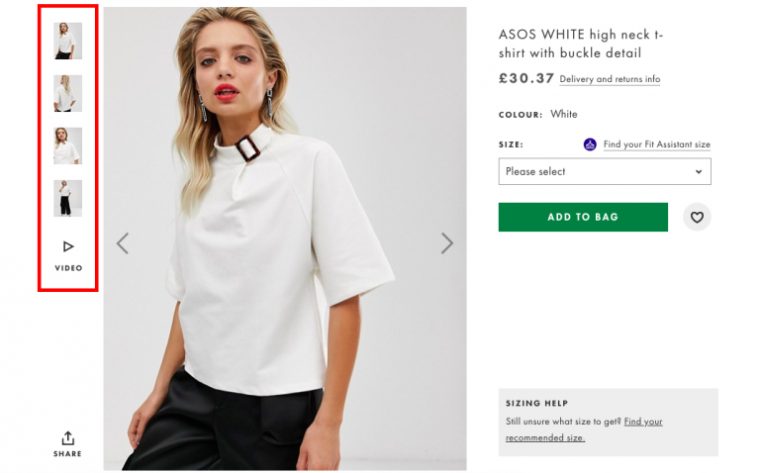Let’s talk about product images as the most important content in your eCommerce website, or is it?
Do not underestimate the importance of product photography because this is one of the most powerful tools in selling of your goods. Humans are visual beings, we process information based on what we see. Studies show that people remember 80% of what they see and 20% of what they read.
According to a research from ViSenze, 62% of generation Z and Millennial consumers want visual search capabilities. Pinterest CEO Ben Silbermann says: “The future of search will be about pictures rather than keywords”. Instead of searching for words, users can drag or snap a photo of clothes, furniture or home decor, etc, without having to describe what they are looking for in a search box with Google Lens.


Talking about visual, the most important thing connected to eCommerce are the images of your products. Great images can increase your sales. Here are some basic tips on what your product photography should look like, depending on what you sell online:
Minimalism and simplicity is the key.
Your product should be in focus. Try not to put too many visual elements in one photo, just one main, which is your product. The background should be solid, white, gray, or light colored. You should brighten the background and remove any shadows, but don’t edit the photos too much, products have to look the same as they are in reality.
In fact, according to a Weebly research, 22% of online product returns are because the ordered items look different than in the photos. Also, minimize the elements on your website that can grab your shoppers’ attention away from your product images.
Consider alternative views of the product you sell.
The more visual information a potential customer has, the more he or she is willing to buy it. Google recommends that back views and close-ups can be used for additional images, but not the main image, also the product should take no less than 75%, but not more than 90% of the full image.
According to studies by Shopify about online consumer preferences, only 0.52% want to see a single product photo, 33.16% prefer to see multiple photos and about 60% prefer images that will enable them to have a 360º vision of the product.
Invest in a good photography service and even better photos.
High-quality photos of products showing customers that you are serious in your business provides them with more security. But, great product photos don’t mean anything if they take too much time to load, in that case your bounce rate would be off the charts. Be careful about images size, if a customer has to wait for more than 2 seconds to load a photo you will lose your game.
If you think that hiring a professional photographer is too expensive, you are going in the wrong direction (causing missed selling opportunities), this can actually save you money in the long run. Make sure the images are blur, noise and pixelation free.
Consistency is the key.
Plan in detail what every set of photos should look like, from the background to the lighting, editing and the creation of a unique template. Every product should be photographed in the same way and conditions. When all product photos are similar, a customer can easily scan through your pages and pick out the product they are looking for.
Have unique images.
To properly rank and optimize images for website sales, the photos that you have in your e-commerce store should be original. If a site features unoriginal photos of products, users could end up on different websites that feature the same products, with no difference between them. When merchants create unique images, they separate themselves from others.
As a perfect example of a webshop that has ideal product photos (according to the standards mentioned above), we choose ASOS (As Seen on Screen). ASOS is a content heavy site that uses photography in many different ways. Landing on the homepage, you can’t see basic product photos, but collection photoshoots, which are presented in a more creative way. ASOS also adds product videos, where shoppers can visually experience the products in a better way, which increases their sales.


All of these suggestions can be helpful for the optimization of your future Google Shopping campaigns. Google shopping is a visual experience, which means that your product images are the most important part of your listing.
Did you know that the images on your site, including product photos, can contribute to your SEO?
Optimizing your product images and photos for search engines is a great way to gain interested customers for your products. There are a few ways to do it:
- Name your image file. Images titles like ”image01.jpg” don’t help Google or consumers. When naming photos, use words that describe the image clearly. Avoid making too long file names and stuffing it with keywords because they could have a negative impact on your ranking.
- Alt text on images. Search engines have a hard time interpreting images, they depend mostly on file (images) names and the alternative text. The purpose of the alt text is to describe images to Google or other search engines so they can understand them.
- Image size and types. JPEG is the most frequently used file type for e-commerce stores because it allows high-quality photo preview with a smaller file size. As previously mentioned, the smaller image file size can play a role in increasing the load speed. Significant page load times can decrease your ranking and can mean lost sales.
No matter how amazing your products are, taking compelling photos of your products is critical to succeed. You have to bear on your mind that buyers can’t touch or hold your products in their hands, they only have the photos.
And what about you?
How many times have you bought something online because of good looking product photos? What are some of your other decision-making reasons while you shop online?
Let us know in the comments below!
The post The importance of product photography in eCommerce appeared first on Inchoo.
Ecommerce
via https://www.AiUpNow.com
Josipa Bjelobrk, Khareem Sudlow
